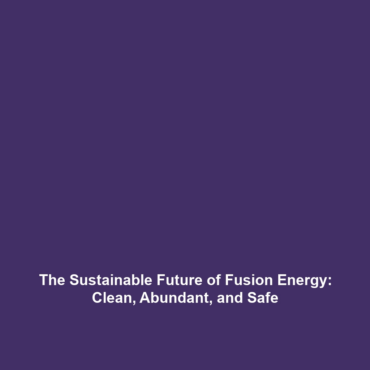Advantages of Fusion Energy: A Sustainable Solution
Introduction
Fusion energy represents a groundbreaking advancement in sustainable power generation, embodying a solution to the world’s escalating energy demands. As the search for clean, abundant energy intensifies, fusion energy is increasingly viewed as a key player in mitigating climate change. Notably, it produces minimal waste, generates no greenhouse gases, and relies on an ample supply of fuel sources such as isotopes of hydrogen. Understanding the advantages of fusion energy is critical as we strive towards a future of sustainable energy solutions.
Key Concepts
Fusion energy refers to the process of merging light atomic nuclei to form heavier nuclei, a reaction that releases vast amounts of energy, similar to the natural processes occurring in the sun. The significant advantages of this energy source include:
- Sustainability: Fusion provides a long-term solution to energy needs without depleting resources.
- Minimal Waste: The waste produced is significantly lesser than that from fossil fuels or fission reactors.
- No Greenhouse Gas Emissions: Fusion does not emit harmful greenhouse gases during operation.
- Abundant Fuel Sources: Fuel for fusion, primarily isotopes like deuterium and tritium, are widely available.
Applications and Real-World Uses
The advantages of fusion energy are not just theoretical; they have practical applications that can revolutionize energy production. For instance:
- Electricity Generation: Fusion reactors could provide vast amounts of electrical power, supporting both residential and industrial needs.
- Space Exploration: Fusion has potential applications in powering spacecraft, enabling longer missions beyond Earth.
- Desalination Processes: Fusion energy may assist in desalinating water, addressing global water scarcity challenges.
These examples highlight how fusion energy could significantly impact various sectors, emphasizing the importance of understanding its advantages.
Current Challenges
Despite its promise, several challenges remain in the path of fusion energy development:
- Technical Complexity: Achieving and maintaining the necessary conditions for fusion is technologically challenging.
- Cost of Development: The financial investment for research and infrastructure is substantial.
- Regulatory Hurdles: Navigating the regulatory frameworks for fusion technology poses significant obstacles.
Future Research and Innovations
The future of fusion energy is bright, with several promising research avenues underway:
- Tokamak Advances: Innovations in tokamak reactor designs aim to increase efficiency and stability.
- Inertial Confinement Fusion: Research in this area looks to minimize energy input while maximizing output.
- Public-Private Partnerships: Collaborative efforts are emerging to accelerate the development of fusion technology.
These innovations could lead to breakthroughs in making fusion energy a viable and sustainable energy solution for the future.
Conclusion
The advantages of fusion energy—its sustainability, minimal waste production, lack of greenhouse gas emissions, and abundant fuel sources—make it an attractive alternative to traditional energy sources. As research progresses and challenges are addressed, fusion may play a pivotal role in meeting global energy demands while protecting the environment. To learn more about these advancements and stay updated on the latest developments in fusion energy, explore our related topics.
